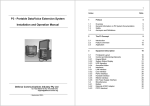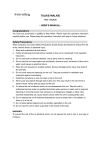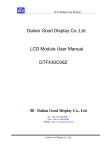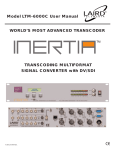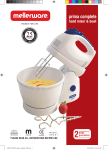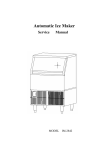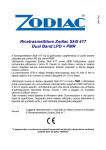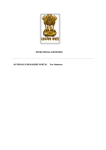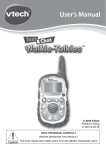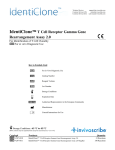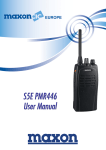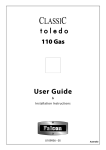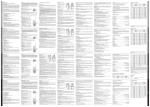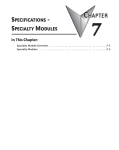Download TracMe user manual
Transcript
Instruction Manual Please read the entire contents of this booklet and follow all instructions. PERSONAL LOCATOR BEACON The Guide to Your TM TracMe Personal Locator Beacon Introduction Quick Reference Cards Mission Warranty ...................................................................... 1 The TracMe Story and Why it Works............................ 2 How TracMe Works..................................................... 4 Why Just One Use?...................................................... 5 Basic Care of Your TracMe PLB..................................... 5 Disclaimer (the Legalese).............................................. 5 The Do’s and Don’ts.................................................. 6,7 General Specifications and Approvals...........................7 How to Activate Your TracMe ...................................... 8 Alternatives after You Activate Your TracMe................10 Incorrect Activation..................................................... 12 A Guide to TracMe’s Features..................................... 14 TracMe Security Seal/Replacement Date......................15 Self Test Procedures.....................................................16 Closing the Gap Between Lost and Found..................18 Contact Us T Office +61 4 1987 5367 (Australia) www.TracMe.com.au TracMe™Beacons Pty Ltd 691-717 Leakes Road Plumpton, Victoria Australia 3335 International/US Patents Pending/Patented in Canada Patent No. PCT/AU2004/001614 Forth Edition June 2009, Model TPLB-1 First of all... Thank you for buying a TracMe Personal Locator Beacon (PLB) and taking the time to read this instruction booklet. TracMe is the smallest and lightest Personal Locator Beacon available today. Through technology, innovation, and low cost, TracMe offers a lighter-weight and more affordable alternative in most situations to units such as a 406 MHz satellite PLB (see page 2 for further details), and an increased level of safety to all outdoor enthusiasts whether on land, sea or in the air. Using a TracMe only changes one important thing: you are easier to find. It’s still important to carry your10 essentials (TracMe is your 11th essential), know where to navigate, leave behind information about your trip, and when you expect to return. For your recycled convenience... Take a look at the back of the plastic packaging. We’ve already recycled it for you into three information cards you create when separating the insert card: 1. A Quick Reference Card - a shorter version of this book. 2. A Dashboard Card - in case you are lost and your car is the last one at the trailhead, it will help rescuers to know that you have a TracMe so they can find you faster. Behind Card - jot down some information about your 3. A Leave-B trip and the local law enforcement office phone contact where you will be hiking or adventuring. If you do become lost, your family, friend, roommate or spouse will appreciate what you’ve left behind, as will your rescuers. Our Mission... TracMe develops innovative technology that will help find you faster. Our Warranty... 1. If your TracMe fails a Self Test within the first 12 months after purchase, logon to www.TracMe.com/FAQ/Warranty for return/replacement instructions. 2. After you purchase your TracMe, be sure to fill in your Warranty information online at www.TracMe.com/ContactUs so we can keep in touch with you about product updates. Don’t forget your 11th Essential 1 The TracMe Story and Why it Works The TracMe Personal Locator Beacon (TracMe) is a low-powered audio response, Personal Locator Beacon (PLB) designed for use in locating lost or distressed people while participating in general outdoor activities. The TracMe system is designed to be an affordable alternative in most situations - but not a replacement to units such as a 406 MHz satellite-based personal locator beacon system. It is designed for general outdoor activities. However, in some situations, you are required by law to carry a satellite PLB. For general activities not requiring a satellite PLB, the TracMe is a much better choice because it is affordable, lightweight, and avoids major problems if inadvertently activated. TracMe is not a satellite PLB. The TracMe system relies on the person being reported as missing before a search is instigated, thereby minimizing the possibility of a false alarm. It is also compatible with common frequencies used in more than 100 million trail radios around the world (FRS/GMRS Ch1 - USA, PMR Ch8 - Europe, UHF CB Ch5 Australia). It relies on you leaving information about your trip and your expected return time. Once you have been reported as missing, searchers can efficiently home in on the signal from the activated TracMe and provide you with assistance as soon as possible. Satellite PLBs are expensive. Due to the high cost of operating and following up false alarms on the satellite PLB system, and the high cost of the units themselves, the satellite PLB system is not generally suitable for use by the general public. With the satellite PLB system, all activations are automatically registered and processed by a central office and must be followed up. This is an expensive process, and with up to 97% of activations resulting in false alarms, a lot of search and rescue resources are wasted. Accidents and abuse are expensive. In some areas, it is an offense to activate a satellite PLB inappropriately or by accident. This is punishable by a fine or jail term. This makes them unsuitable -- particularly for use by children and the elderly. 2 www.TracMe.com.au When activated,your TracMe transmits a radio signal with an audio message "Help…Emergency" which can be understood and interpreted as a distress message by anyone listening to that radio channel within range. This message repeats for up to 7 days approximately every 15 seconds. Common technology and no special equipment makes it easier for rescuers to find a TracMe. After the TracMe has been activated, searchers can efficiently home in on the signal from the activated TracMe without the need for any specialized direction finding equipment other than a TracMe antenna and a UHF radio receiver with a Received Signal Strength Indicator (RSSI). Many of the newer UHF CB radios, scanners and FRS/GMRS radios have this type of indicator as standard. Land and Air Search Capabilities. A light plane can also be used to initially speed up the location of the activated TracMe. From the air, the signal from an activated TracMe can be picked up from approximately 8kms (5 miles) away, even with poor visibility or with dense ground cover. With specialist equipment this can be as far as 20 miles (30kms). From this, the position of the activated TracMe can be narrowed down to an area approx 1 km (1/2 mile) radius. This information is then passed on to a ground crew who can complete the search and rescue operation. TracMe.com has detailed Search and Rescue instructions. The TracMe team continues to refine and improve the beacon’s design, and conducts workshops for search and rescue personnel as well as providing them with periodic updates, free loan equipment to practice search techniques as well as other information. For more information, you can always login to www.TracMe.com.au or contact: Office +61 4 1987 5367 (Australia) Don’t forget your 11th Essential 3 How TracMe Works A TracMe beacon is a simple yet unique device which lasts longer than other beacons available. Its battery, when not activated, lasts approximately 10 years, and its signal, once activated, lasts for up to 7 days. You only need to use it once for it to do its job. The TracMe comes in a storage case. Remove it and wear it when you cycle, hike, paddle, ski or adventure on land, air or water. It should be within reach of either hand and needs only one hand to activate. Always wear your TracMe with the lanyard. To activate the TracMe, pull the yellow bottom of the beacon’s outer case. The bottom pulls out from the upper blue case. Then it begins to transmit a message “BEEP, Help...Emergency” with a female voice that repeats continuously approximately every 15 seconds. This message signal lasts for up to 7 days or until the TracMe is deactivated. TracMe’s advantage is that its signal is received by signal compatible trail radios (FRS/GMRS Ch1 - USA, PMR Ch8 Europe, UHF CB Ch5 - Australia). This technology is commonly used by search and rescue agencies. There are about 100 million trail radios in use throughout the world as of January 2007. Your TracMe is set to work with your local frequency and will be compatible with local rescuers. When the search and rescue is complete, the beacon can be deactivated using these steps: 1. Press and hold the TEST button until the status indicator lights. 2. Release the TEST button before the indicator goes off. 3. Wait for the indicator to come on again and then press and release the TEST button momentarily. 4. Successful deactivation is signalled by the indicator flashing: red, green, red, green,…until the battery is exhausted. The TracMe is now deactivated, and will run without transmitting any signal until the battery is exhausted. The TracMe cannot be re-activated as it is designed to be used only once. Dispose properly. If the TEST button is jammed or broken, cut or break off the antenna from the TracMe and place the unit into a sealed metal container for disposal. The unit will then operate normally until the battery is exhausted. DO NOT crush or attempt to destroy the TracMe to deactivate since it contains a Lithium battery. 4 www.TracMe.com.au Why just one use? There is a method to the madness from Down Under: with a TracMe you won’t abuse the privilege of your rescue and all the resources surrounding it. We believe in personal responsibility, map reading, and good outdoor skills. Once activated, the TracMe beacon cannot be reused. It must then be deactivated, discarded and replaced with a new unit. We will replace your TracMe free of charge if you use it when hurt or lost to activate an official search and rescue. See the last page of this book for details. Basic care of your TracMe PLB... Keep your TracMe away from extreme heat - store it below 60degC (140degF). For example, do not leave your TracMe on a vehicle dashboard in the sun. Once your TracMe has been activated, placing the TracMe back into its outer case will not deactivate the unit or make it re-useable. After reading the fine print below, turn the page for more tips. Disclaimer for the TracMe PLB TracMe Beacons P/L, its contractors, agents and staff are in no way liable for any loss or damage whatsoever (including special, indirect or consequential loss or damages) arising out of or in connection with the use or performance of the TracMe, whether at common law (including in contract and in tort including negligence), in equity, pursuant to statute or otherwise. This disclaimer does not exclude, restrict or modify warranties or conditions that TracMe Beacons P/L cannot, by law exclude, restrict or modify. In the event that TracMe Beacons P/L is found to be liable for breach of any such warranty or condition, to the extent permitted by law, the liability of TracMe Beacons P/L shall be limited, at its option, to 1) the replacement of the TracMe, the supply of equivalent goods, or the repair of the TracMe; or 2) payment of the cost of replacing the TracMe or acquiring equivalent goods. Don’t forget your 11th Essential 5 Do... 1. Read all Self Test and beacon usage instructions (on p. 16 and 17) before leaving on your trip. 2. Plan your expedition, hike, or extended backcountry/ paddling trip carefully; don't forget your 10 Essentials. Your TracMe is your 11th Essential. Before your departure, leave written instructions about your location and itinerary with the phone number of the nearby County Sheriff and display your TracMe card at home and in your car. 3. Store your TracMe in a dry location. 4. Self Test your TracMe before your trip; it is critical that you follow each function described in this Instruction Manual. 5. Replace your TracMe before your trip if it fails the Self Test instructions. It is warrantied for replacement within 12 months of purchase. Return it to the retailer of purchase. 6. Self Test your TracMe during your trip using the directions in this Instruction Manual. We recommend carrying a spare TracMe beacon. 7. Replace the TracMe if the security seal is broken or it has passed its replacement date (See the decal on back of your TracMe beacon). 8. Wear your TracMe so that you can grab it easily with either hand. 9. Use the TracMe only in the country indicated on the rear of your TracMe. Different countries use different radio rescue frequencies. Approvals Any changes or modifications to the device not expressly approved by the party responsible for compliance could void the user's authority to operate this device. This device complies with all relevant parts of the FCC rules. F.C.C. - TAI0000TB1 I.C. - 5872A-0000TB1 C-Tick - N14946 Patent No.- PCT/AU2004/001614, Model TPLB-1 (Australia) Trademark - TMA 688084, Model TPLB-1 (Canada) United States and other international patents pending. All components used to manufacture TracMe are qualified as being lead-free under RoHS under the European Union standard, effective July 1, 2006. 6 www.TracMe.com.au Don't... 1. Do not use or attempt to use a TracMe that has had its security seal broken. 2. Do not immerse your TracMe into water below the depth specified in this Instruction Manual. 3. Do not attempt to activate your TracMe other than as written in this Instruction Manual. 4. Do not activate your TracMe unless you are lost, injured or require serious medical attention. 5. Do not leave the vicinity of your TracMe once you have activated it. 6. Do not deactivate your TracMe until help has arrived and you have been rescued. 7. Do not attempt to re-use your TracMe once deployed. Use once only as directed, and then return your expended unit to TracMe Beacons P/L (see the back cover of this Instruction Manual for details). 8. Do not throw away your TracMe; it has a lithium battery. Contact us to return it, or if it is past its 12-month warranty, dispose of it in a sealed container. General Specifications Operating temperature -40degC to +60degC (-40degF to 140degF) Storage temperature -40degC to +70degC (-40degF to 160degF) Transmit frequency (Factory set) USA/Canada FRS Ch1(462.5625MHz) Australia UHF CB Ch5(476.525MHz) Europe PMR Ch8 446.09375MHz) Transmit power less than 10mW Transmission type FM audio (FE3) Transmitted message factory recorded, up to 3 seconds of audio Message format message repeated every 15 seconds Duration of operation once activated, operation time will be approximately 7 days at 25 deg C (75degF) Reuse after deactivation not possible Deactivation system operate the TEST button in a set sequence Water proof submersible to 1m (3ft); will not operate under water Buoyancy will float Indicators Green LED, red LED. See detailed description. Weight 46gm (1.6oz) Size 82 x 46 x 24mm (3.2" x 1.8" x 0.9") County of Manufacture Made in Australia. Don’t forget your 11th Essential 7 How to Activate your TracMe Personal Locator Beacon 1 2 8 www.TracMe.com.au 3 Don’t forget your 11th Essential 9 Alternatives After You Activate Your TracMe There may be times when it is not practical to keep your TracMe attached to you. Steps 4 and 5 illustrate other alternatives to keep you safe and help rescuers find you. Attach the beacon to a belt loop, a backpack you are wearing; lay or hang it nearby. Always keep the lanyard attached to your TracMe. 4 Detach ribbon here if required. 10 www.TracMe.com.au Antenna is fully extended 5 or 6 Be sure to position the beacon so that the antenna points upward. Don’t forget your 11th Essential 11 Incorrect Activation This is how NOT to do it! Remember, activating your TracMe is a single-handed effort. The TracMe cannot be activated by holding onto the dark blue outer case. 12 www.TracMe.com.au Once activated, your TracMe will transmit the prerecorded distress message on the UHF radio band (FRS/GMRS Ch1 - USA, PMR Ch8 - Europe, UHF CB Ch5 - Australia). The short message will be transmitted approximately every 15 seconds for up to 7 days. The transmitted distress voice message is “Help...Emergency.” This will immediately alert anyone listening on the radio to your emergency situation. The transmitted signal from the activated TracMe will then act as a homing beacon allowing rescuers to quickly find the TracMe. Always stay next to or near your TracMe once it has been activated. A correctly activated TracMe Personal Locator Beacon. In this state, it transmits the “Help....Emergency” voice message. Don’t forget your 11th Essential 13 1 3 2 9 7 8 6 5 4 TracMe PLB Features 1. 2. 3. 4. Attachment point Release pin Outer case TracMe Beacon Unit with Security Seal and Replacement Date 5. 6. 7. 8. 9. Status indicator Test button/SELF TEST Hang ribbon Antenna Lanyard A Guide to TracMe’s Features 1. Attachment Point This is used to attach the TracMe to a suitable point on your body. It should be somewhere easily accessible by both hands in the event of an emergency -- remember, in this situation, one or the other hand may be incapacitated. The attachment point should be secure enough so that the TracMe will not come free during activation. Use the supplied lanyard to wear around your neck. 2. Release Pin This pin is part of the activation mechanism of the TracMe. Please read the section "Activating the TracMe Beacon" for a full description. 3. Outer Case This holds the main TracMe Beacon unit until it is activated. 14 www.TracMe.com.au 4 4. TracMe Beacon Unit, Security Seal and Replacement Date This contains the actual beacon transmitter. As part of the activation process, this part is removed from the Outer Case. Please read the section "Activating the TracMe Beacon.” The label on the rear of your TracMe Beacon Unit shows important information about the TracMe unit. The “Replacement Date” is the date 10 years after the date of manufacture of the TracMe unit. Your TracMe should be replaced with a new unit after this date even if it has not been previously used. The label on the rear of your TracMe unit also has a “Security Seal.” If the label has been broken, then the unit has been opened at some time, and may therefore be no longer useable. The TracMe unit should then be discarded and replaced with a new unit. Don’t forget your 11th Essential 15 1 3 2 9 7 8 6 5 4 TracMe PLB Features, continued 1. 2. 3. 4. Attachment point Release pin Outer case TracMe Beacon Unit with Security Seal and Replacement Date 5. 6. 7. 8. 9. Status indicator Test button/SELF TEST Hang ribbon Antenna Lanyard 5. Status Indicator Shows the result of the Self Test and deactivation process as outlined in (6) below. Also, when the TracMe has been activated, the Status Indicator will flash GREEN each time the TracMe transmits its distress signal voice message (approximately every 15 seconds for up to 7 days). 6. Test Button and Self Test Procedures TracMe’s Test Button has two functions: 6A. Self Test - Test the viability of the TracMe unit at any stage during its lifetime. At any time when the TracMe is not in its activated state, a Self Test procedure can be performed by pressing the test button (using a pointed object such as a pen or paper clip). The status indicator (6) will flash GREEN if the TracMe passed the Self Test procedure. 16 www.TracMe.com.au The following tests are performed during the Self Test procedure: - Check the battery condition - Check the operation of the electronic circuits - Check if the transmitter is operational If the TracMe fails the Self Test (indicator flashes RED) it is no longer useable and should be discarded and replaced with a new unit. See Our Warranty on Page 1 for replacement information. 6B. Deactivation - If the TracMe is in its activated state (for example, if the inner and outer case are separated) then pressing the Test button in the following sequence will deactivate the TracMe: - Press and hold the Test button until the status indicator lights up; then release the Test button. - When the Status indicator lights again, press and release the Test button momentarily. The Status indicator will flash RED/GREEN continuously until the battery is exhausted. During this time the TracMe no longer transmits its distress signal. The TracMe cannot be used and should be replaced with a new unit. 7. Attachment and Hanging Ribbon The function of this ribbon is to prevent the beacon unit from falling away after the TracMe has been activated. This is useful in situations where the person activating the TracMe is rock climbing, in a stream or situations where the TracMe must remain attached to the person once activated. In certain situations it might be necessary to separate the TracMe beacon from its outer housing after it has been activated. This is useful in the situation where the unit must be placed in a suitable position while the person takes shelter -- for example, the TracMe can be hung up in a tree while the person shelters in a snow cave. To separate the TracMe from its outer housing, tear the ribbon section at the point illustrated in Step 4 shown previously. 8. Antenna The spring loaded antenna will pop up automatically when the TracMe unit is activated. When positioning the activated TracMe beacon on the ground, position it with the antenna upwards in a clear open area if possible. 9. Lanyard Always wear the lanyard when carrying your TracMe. Note the information tag. Don’t forget your 11th Essential 17 Closing The Gap Between Lost and Found That’s why TracMe was created in the first place. If you visit www.TracMe.com, you’ll read about several situations which gave Joe and Tilo a personal mission to save lives. Saving time can be critical when initiating and conducting a rescue and locating a missing and possibly injured person. Lost and found success stories are the bottom line for the TracMe team. You are the key element in keeping yourself safe. And we are part of that preparation in using the Dashboard Card, the Leave-Behind Card and bringing your Quick Reference Card. Then there are your rescuers. Let’s keep them safe too and enable them to find you as soon as possible. TracMe is your 11th Essential, along with all of the basics you and your fellow adventurers should pack to make it a fun adventure and not an epic. If you do pull the yellow bottom of your TracMe in an official rescue situation, we hope that you will be okay. We want to know all about it. Tell us your story by logging onto www.TracMe.com/FAQ/YourRescue. You’ll receive a return email (and a phone call) with arrangements for us to replace your TracMe free of charge. We also hope that you choose to share your happy ending, lessons learned and praise for your rescuers with the TracMe community. We hope you find TracMe in all the places which prepare you for your next adventure. Educate, prepare, pack, and inform those you have left behind. Happy trails! ©TracMe Personal Locator Beacon Pty Ltd 2015 International/US Patents Pending/Patented in Canada Patent No. PCT/AU2004/001614 Fourth Edition June 2009, Model TPLB-1




















